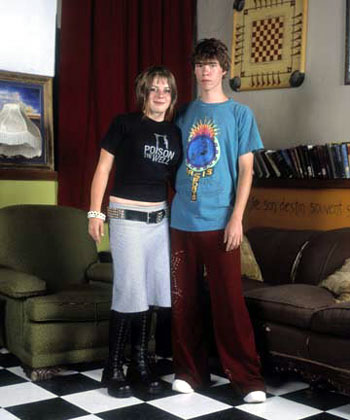Capital
City Arts Initiative
The
Carson City | Carson Valley Portrait Project: Exploring Community
essay by Marcia
Tanner
|
Spore’s approach to portrait making is deceptively
simple. He asks his subjects to pose neutrally, as though they are
having a casual conversation. “I give little direction,” he
says, “but I try to avoid the smiling ’snapshot’.” He
centers the subjects in the frame and prints the images the “contexts” are
lively: the café’s funky jumbled interior, the bare
wall and patterned carpet in an upstairs hotel room at J.T.’s.
Spore is acutely aware of the long, rich tradition of portrait
photography as an art form, and has thoughtfully considered his
place within it. Unlike celebrity
portrait photographers such as Richard Avedon and Annie Liebowitz, he tries,
as much as possible, to be invisible in his work. He wants the subject of the
portrait to be the subject. His model and inspiration is Michael Disfarmer,
a commercial photographer working in rural Arkansas in the mid-20th
Century who
made hundreds of family portraits of ordinary working people. In the 1970’s,
Disfarmer’s images were discovered and later collected in book form.
"When I first viewed the book of Disfarmer portraits I was immediately
drawn to the simple, straightforward, evenly lit style," Spore says. "There
was no 'artistic interference' between
me the viewer and the people he photographed. [I had] a profound sense of privilege
-- a sense of being allowed access to a private and real person. Disfarmer’s
subjects dressed simply and presented themselves . . . without pretense. There
was an honesty and directness that I found compelling and in stark contrast
to our contemporary world of advertising and fashion." [2]
Whether or not it is possible, let alone desirable, for an artist to be totally
objective and entirely self-effacing is open to discussion. The medium of photography
lends itself to such questions more than others, because it is supposedly the
medium of “truth” -- although that notion has been so thoroughly
challenged as to be discredited in recent years, especially since the advent
of digitally manipulated photographic images.
Even without that technology, the claim that photography can present unvarnished
reality is debatable. There is always someone, an actual person, behind the
camera, who is making choices about what will be seen in the photographic image.
This
is especially the case when that person is an artist. Spore might aim toward
a factual way of representing what he sees, but there is a thrilling creative
tension between detachment and commitment in his work. Underneath the cool,
apparently unemotional presentation of his portraits is a highly subjective
vision and a
passionate interest in the subjects he depicts. Why would we look at them otherwise?
He admits as much:
"I am interested in exploring -- and having the viewer explore -- questions
of community. Even in this age of television and our heavily mediated society,
we
each live in a unique community. What does it mean to have large-scale portraits
of people in a community displayed in a gallery exhibition? What is the artistic
experience? I hope the images will stir up questions about personal decisions. “Why
do I live here? Do I feel part of or estranged from these people? How do people
create a community? How do people define community? What are our shared values?
How do we approach diversity?” These are all important questions in examining
our experiences and ourselves." [3]
Beyond these questions is the inescapable fact that you are looking at portraits
of real people who were photographed in a real place in real time, not so long
ago on the streets where you live. Whether you know them or not, your encounter
with their images here and now may make you see them in a new way, may create
an emotional bond between you and them, may even pierce your heart.
Marcia Tanner
Berkeley, California
February 2004
2 Email
from the artist, January 26, 2004.
3 Ibid.
Recommended Reading
Carol Squiers, Christopher Phillips, Brian Wallis, Edward W. Earle,
et. al., Strangers: The First ICP Triennial of Photography
and Video, New York, NY and Steidl, Gottingen, International Center
of Photography, 2002-2003.
Julia Scully, Disfarmer, Heber Springs Portraits 1939-1946, Santa Fe, New Mexico: Twin Palms Publishers, 1996.
Max
Kozloff, Lone Visions - Crowded
Frames:
Essays on Photography, Albuquerque,
New Mexico:
University of New Mexico Press, 1994.
Richard
Bolton, Editor, The Contest
of Meaning:
Critical Histories of Photography,Cambridge,
Mass:
MIT Press, 1989.
Liz
Wells, Editor, The Photography
Reader,
London
and New York: Routledge, 2003
Capital City Arts Initiative
